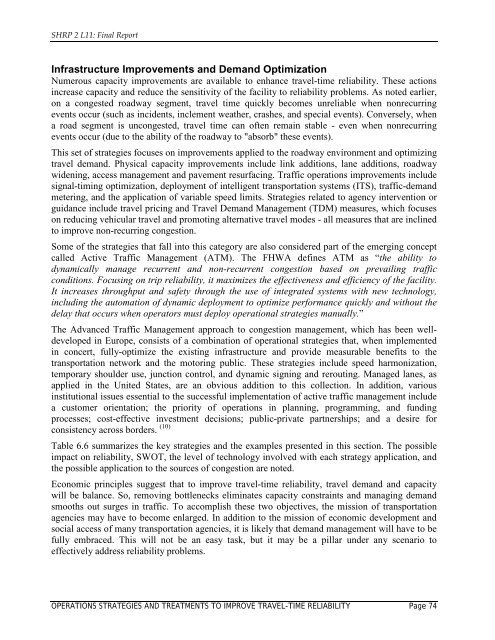Evaluating Alternative Operations Strategies to Improve Travel Time ...
Evaluating Alternative Operations Strategies to Improve Travel Time ...
Evaluating Alternative Operations Strategies to Improve Travel Time ...
You also want an ePaper? Increase the reach of your titles
YUMPU automatically turns print PDFs into web optimized ePapers that Google loves.
SHRP 2 L11: Final Report<br />
Infrastructure <strong>Improve</strong>ments and Demand Optimization<br />
Numerous capacity improvements are available <strong>to</strong> enhance travel-time reliability. These actions<br />
increase capacity and reduce the sensitivity of the facility <strong>to</strong> reliability problems. As noted earlier,<br />
on a congested roadway segment, travel time quickly becomes unreliable when nonrecurring<br />
events occur (such as incidents, inclement weather, crashes, and special events). Conversely, when<br />
a road segment is uncongested, travel time can often remain stable - even when nonrecurring<br />
events occur (due <strong>to</strong> the ability of the roadway <strong>to</strong> "absorb" these events).<br />
This set of strategies focuses on improvements applied <strong>to</strong> the roadway environment and optimizing<br />
travel demand. Physical capacity improvements include link additions, lane additions, roadway<br />
widening, access management and pavement resurfacing. Traffic operations improvements include<br />
signal-timing optimization, deployment of intelligent transportation systems (ITS), traffic-demand<br />
metering, and the application of variable speed limits. <strong>Strategies</strong> related <strong>to</strong> agency intervention or<br />
guidance include travel pricing and <strong>Travel</strong> Demand Management (TDM) measures, which focuses<br />
on reducing vehicular travel and promoting alternative travel modes - all measures that are inclined<br />
<strong>to</strong> improve non-recurring congestion.<br />
Some of the strategies that fall in<strong>to</strong> this category are also considered part of the emerging concept<br />
called Active Traffic Management (ATM). The FHWA defines ATM as “the ability <strong>to</strong><br />
dynamically manage recurrent and non-recurrent congestion based on prevailing traffic<br />
conditions. Focusing on trip reliability, it maximizes the effectiveness and efficiency of the facility.<br />
It increases throughput and safety through the use of integrated systems with new technology,<br />
including the au<strong>to</strong>mation of dynamic deployment <strong>to</strong> optimize performance quickly and without the<br />
delay that occurs when opera<strong>to</strong>rs must deploy operational strategies manually.”<br />
The Advanced Traffic Management approach <strong>to</strong> congestion management, which has been welldeveloped<br />
in Europe, consists of a combination of operational strategies that, when implemented<br />
in concert, fully-optimize the existing infrastructure and provide measurable benefits <strong>to</strong> the<br />
transportation network and the mo<strong>to</strong>ring public. These strategies include speed harmonization,<br />
temporary shoulder use, junction control, and dynamic signing and rerouting. Managed lanes, as<br />
applied in the United States, are an obvious addition <strong>to</strong> this collection. In addition, various<br />
institutional issues essential <strong>to</strong> the successful implementation of active traffic management include<br />
a cus<strong>to</strong>mer orientation; the priority of operations in planning, programming, and funding<br />
processes; cost-effective investment decisions; public-private partnerships; and a desire for<br />
consistency across borders. (10)<br />
Table 6.6 summarizes the key strategies and the examples presented in this section. The possible<br />
impact on reliability, SWOT, the level of technology involved with each strategy application, and<br />
the possible application <strong>to</strong> the sources of congestion are noted.<br />
Economic principles suggest that <strong>to</strong> improve travel-time reliability, travel demand and capacity<br />
will be balance. So, removing bottlenecks eliminates capacity constraints and managing demand<br />
smooths out surges in traffic. To accomplish these two objectives, the mission of transportation<br />
agencies may have <strong>to</strong> become enlarged. In addition <strong>to</strong> the mission of economic development and<br />
social access of many transportation agencies, it is likely that demand management will have <strong>to</strong> be<br />
fully embraced. This will not be an easy task, but it may be a pillar under any scenario <strong>to</strong><br />
effectively address reliability problems.<br />
OPERATIONS STRATEGIES AND TREATMENTS TO IMPROVE TRAVEL-TIME RELIABILITY Page 74















